Zoom
Trash

Thegionfestival
Hashi Benkei Yama 橋弁慶山 - Tale of Courage & Loyalty - Gion Festival. Hashi Benkei Yama depicts a famous scene in Japanese and Kyoto history, when the gigantic warrior monk Benkei challenged the diminutive but superhuman youth Ushiwakamaru on Kyoto’s Gojō Bridge, located about a mile from this float.
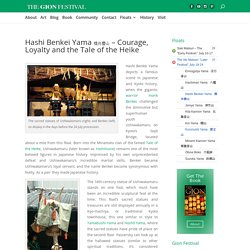
Born into the Minamoto clan of the famed Tale of the Heike, Ushiwakamaru (later known as Yoshitsune) remains one of the most beloved figures in Japanese history. Impressed by his own unprecedented defeat and Ushiwakamaru’s incredible martial skills, Benkei became Ushiwakamaru’s loyal servant, and the name Benkei became synonymous with fealty. Tokusa Yama 木賊山 - Noh: Poignant Separation & Reunion * The Gion Festival. Tokusa Yama features the central figure from a noh play and chant, “Tokusa,” by the 14th-century genius Japanese playwright and philosopher Zeami.
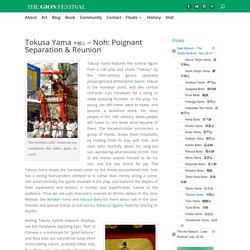
Tokusa is the horsetail plant, and the central character cuts horsetails for a living to make scouring brushes. In the play, his young son left home, went to Kyoto, and became a Buddhist monk. Suzuka Yama 鈴鹿山: The Demon – Pacifying Goddess. Kikusui Boko 菊水鉾 – The Chrysanthemum Dew Float. Tokusa Yama 木賊山 – Noh: Poignant Separation & Reunion. The Kuronushi Yama 黒主山 – An Immortal Poet. The Damask Umbrella Float. Hakuga Yama 伯牙山 * The Gion Festival. Hachiman Yama 八幡山: Protector God of Warriors. Ofune Boko 大船鉾 – The Great Ship Float. Jomyo Yama Honoring Courage in Battle. Gion Festival Ebook. Kyoto’s famous gion festival.
Kyoto’s Famous Gion Festival. Gion Festival 2021 Prospects. Will there be a Gion Festival 2021?
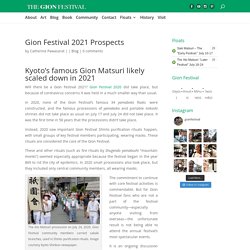
Gion Festival 2020 did take place, but because of coronavirus concerns it was held in a much smaller way than usual. In 2020, none of the Gion Festival’s famous 34 yamaboko floats were constructed, and the famous processions of yamaboko and portable mikoshi shrines did not take place as usual on July 17 and July 24 did not take place. It was the first time in 58 years that the processions didn’t take place.
Instead, 2020 saw important Gion Festival Shinto purification rituals happen, with small groups of key festival members participating, wearing masks. These rituals are considered the core of the Gion Festival. Things you should know about gion matsuri. The Victorious Return of Ōfune Boko * The Gion Festival. Ancient Tradition Meets High Tech With an 1100-year history, the Gion Matsuri or Gion Festival is working with an unusually long-term perspective.
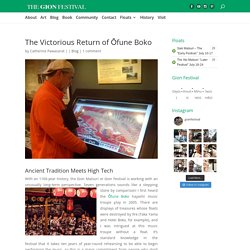
Seven generations sounds like a stepping stone by comparison! I first heard the Ōfune Boko hayashi music troupe play in 2005. There are displays of treasures whose floats were destroyed by fire (Taka Yama and Hotei Boko, for example), and I was intrigued at this music troupe without a float. Gion Festival 2021 update: 18 Yamaboko Floats to be Built and Decorated, Preserving Traditions * The Gion Festival. Though the Gion Festival floats processions have been canceled in 2021 for the second year in a row due to covid, Gion Festival Yamaboko Floats Association officials and Yasaka Shrine representatives announced that 18 floats would be constructed and decorated this year.

Building the gigantic Gion Festival floats requires an extremely specialized form of carpentry. Its ongoing transmission to a younger generation of carpenters is essential to conserve the techniques for the future, announced the Floats Association officials. Moreover, for conservation purposes, the floats’ decorations benefit from being aired out once a year. Gion Festival 2021: Small in Size, Big in Heart - Gion Festival. No doubt the Gion Festival community and Kyoto authorities felt heartbroken to scale back the Gion Festival 2021 due to covid.
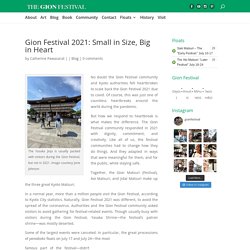
Of course, this was just one of countless heartbreaks around the world during the pandemic. But how we respond to heartbreak is what makes the difference. The Gion Festival community responded in 2021 with dignity, commitment, and creativity. Visit Gion Festival. Where and when to visit the Gion Festival The Gion Festival neighborhoods display their floats in two parts: the larger saki-matsuri (“early festival” from July 10-17) and smaller-scale ato-matsuri (“later festival” from July 18-24).
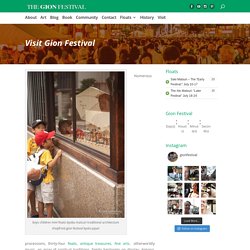
Click on those pages to see which of the larger floats you can actually get on. Visit as many of the treasure display areas as you can, as chances are good that you won’t see many museum-quality treasures like these so close up anywhere else on the planet. Enjoy the Naginata Float in the Gion Festival – Site Title. The Gion festival started as a way to appease the Gods of Yasaka Shrine for the pacification of nature’s wrath and keeping the plague or any epidemic at bay.

The deity is believed to bless Kyoto City and the whole of Japan and protect people from fire, flood, earthquake, and epidemic. Naginata is a kind of Samurai sword mounted on the pole. Things You Should Know About Gion Matsuri. Started in 869 and held every year in July, Gion Matsuri is Japan’s biggest festival that is held in Central Kyoto.
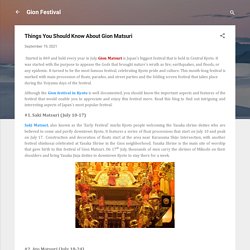
It was started with the purpose to appease the Gods that brought nature’s wrath as fire, earthquakes, and floods, or any epidemic. It turned to be the most famous festival, celebrating Kyoto pride and culture. This month-long festival is marked with main procession of floats, parades, and street parties and the folding screen festival that takes place during the Yoiyama days of the festival. Tōrō Yama 蟷螂山 - Brave as a Mantis * Courage Against the Odds. Everyone delights in the mechanized mantis’s antics during the 17 July procession.
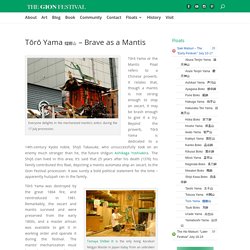
Tōrō Yama or the Mantis Float refers to a Chinese proverb. It relates that, though a mantis is not strong enough to stop an oxcart, it may be brash enough to give it a try. Beyond the proverb, Tōrō Yama is dedicated to a 14th-century Kyoto noble, Shijō Takasuke, who unsuccessfully took on an enemy much stronger than he, the future shōgun Ashikaga Yoshiakira. The Shijō clan lived in this area; it’s said that 25 years after his death (1376) his family contributed this float, depicting a mantis automata atop an oxcart, to the Gion Festival procession. Hakuga Yama 伯牙山 * The Gion Festival. Bo Ya (Hakuga in Japanese) may be the best known musician of Chinese antiquity; he was a virtuoso on the qin, a horizontal Chinese harp that is a symbol of Chinese erudition, in the Spring and Autumn Period (8th-5th century B.C.E.). Incredibly, Bo Ya’s music is still played. The Hakuga Yama float shows Bo Ya with a koto, the Japanese version of a qin.
Though Bo Ya’s skill was widely acknowledged, he felt that no one really understood his music. One day a humble wood cutter named Zhong Ziqi (Japanese: Shōshiki) heard Bo Ya’s music from a distance, and could perfectly interpret what he was expressing. Thereafter a Chinese phrase “to know one’s music” became synonymous with empathic and ideal friendship, transcending differing backgrounds. Niwatori Boko 鶏鉾 * The Gion Festival. Niwatori Boko embodies a celebration of peace. In ancient China, the legendary Emperor Yao (ca. 2300 B.C.E.) ordered a large drum placed in the center of town, instructing residents to beat the drum in case of a complaint.
His reign was so tranquil that eventually chickens nested inside the drum, manifesting a symbol of peace. “Niwatori” means “chicken, and this float celebrates that peacefulness. Niwatori Boko’s 17th-century Gobelin tapestry is an Important Cultural Property, and float records show that the tapestry was purchased in 1815 for 200 ryō. Suzuka Yama 鈴鹿山: The Demon - Pacifying Goddess * The Gion Festival. The Suzuka Yama float pays tribute to the goddess Suzuka Myōjin, protectress of Mt. Suzuka, a mountain peak that straddles Mie and Shiga prefectures. It was on the vital Tōkaidō road linking Edo and Kyoto; its steep paths were ideal for bandit raids, which over time turned into tales of a terrible demon. Iwatō Yama 岩戸山 - The Stone Door Float * The Gion Festival. Sun Goddess Amaterasu in male form, honored at Iwatō Yama’s shrine before the July 17 procession. Iwatō Yama depicts three major deities from Japanese history and mythology: Amaterasu Ōmikami, Tajikara No-Mikoto and Izanagi No-Mikoto.
Their remarkable tales come from the 8th-century Kojiki and Nihon Shoki. These are Japan’s two oldest texts, which document earliest Japanese history and culture. Urade Yama 占出山 - Empress Jingu Divines Her Future * The Gion Festival. Empress Jingū divining her fate during the July 17 procession: the curved instrument she holds is a fishing rod. Urade Yama shows a scene where the 3rd-century Japanese shamaness ruler known as Empress Jingū used fishing as a divining method.
Depending on the number of fish she caught, the gods communicated whether or not she’d be victorious on her potential journey to the land of Silla, part of the modern-day Korean peninsula. Apparently the fish nibbled; “Urade” means roughly, “prophesize and go forth.” Japan’s most ancient texts convey that she traveled to Silla and, with the gods on her side, “conquered” it without fighting, returning to Japan with abundant tribute. Besides Urade Yama, Fune Boko (“Ship Float) depicts Jingū’s ship on its way to Silla, and Ōfune Boko (“Great Ship Float”) is the ship returning, greater for its riches. Ashikari Yama 芦刈山 * The Gion Festival. Hakurakuten Yama 白楽天山 - Zen Teaching: Simply Profound * The Gion Festival. Naginata Boko 長刀鉾 * The Gion Festival The First Float in the Gion Festival. Fune Boko 船鉾 - The Ship Float * The Gion Festival The Ship Float and its legendary Empress Jingu.